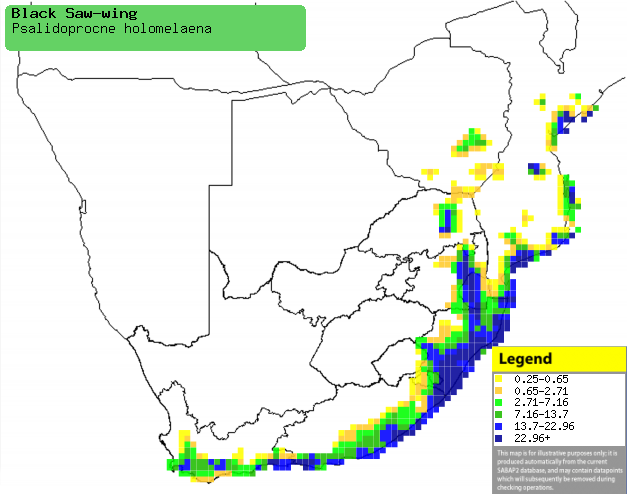|
Psalidoprocne holomelaena (Black
saw-wing)
Swartsaagvlerkswael [Afrikaans]; Inkonjane (generic term
for swallow), Unomalahlana [Xhosa]; Sisampamema (generic term for swallows,
martins, swifts and spinetails) [Kwangali]; Zwarte kamzwaluw [Dutch]; Hirondelle
du Ruwenzori [French]; Sundevalls sägeflügelschwalbe [German]; Andorinha-preta
[Portuguese]
Life
> Eukaryotes >
Opisthokonta
> Metazoa (animals) >
Bilateria >
Deuterostomia > Chordata >
Craniata > Vertebrata (vertebrates) > Gnathostomata (jawed
vertebrates) > Teleostomi (teleost fish) > Osteichthyes (bony fish) > Class:
Sarcopterygii (lobe-finned
fish) > Stegocephalia (terrestrial
vertebrates) > Tetrapoda
(four-legged vertebrates) > Reptiliomorpha > Amniota >
Reptilia (reptiles) >
Romeriida > Diapsida > Archosauromorpha > Archosauria >
Dinosauria
(dinosaurs) > Saurischia > Theropoda (bipedal predatory dinosaurs) >
Coelurosauria > Maniraptora > Aves
(birds) >
Order: Passeriformes > Family: Hirundinidae
Distribution and habitat
Occurs across the DRC, Cameroon, northern Angola and
Zambia, with separate populations in Ethiopia, Kenya to Tanzania and southern
Africa. Here it is common in Swaziland, the southern Mozambique coast and the
eastern escarpment and lowlands of South Africa, from Limpopo Province south to
KwaZulu-Natal and down the coast to Cape Town. It generally favours fringes of
montane, coastal and riparian forests, especially near watercourses or marshes.
It also occupies edges of miombo (Brachystegia) woodland, valley bushveld
and fynbos.
|
 |
|
Distribution of Black saw-wing in southern Africa,
based on statistical smoothing of the records from first SA Bird Atlas
Project (©
Animal Demography unit, University of
Cape Town; smoothing by Birgit Erni and Francesca Little). Colours range
from dark blue (most common) through to yellow (least common).
See here for the latest distribution
from the SABAP2. |
Movements and migrations
Intra-African breeding migrant, arriving in
southern Africa around August-September and leaving around
April-May. The location of its non-breeding grounds hasn't been
confirmed, and there are still birds present from May-August, but it
is quite scarce in this period.
Food
It eats aerial arthropods, doing most of its foraging close
to the ground in clearings between trees, flying slowly while hawking prey.
Breeding
- Monogamous, usually solitary nester, although sometimes semi-colonial.
- Both sexes excavate the nest, which is a upwardly inclined burrow
consisting of a long tunnel ending in a chamber, where a saucer-shaped nest
of lichen and grass is constructed. It is usually dug into a riverbank,
sandbank, erosion gulley, roof of Aardvark Orycteropus afer burrow,
trench or road cutting, with the entrance often concealed by vegetation.
- Egg-laying season is from September-March, peaking around December.
- It lays 1-3 eggs, which are incubated for 14-15 days, although in East
Africa it can be as long as 18 days.
- The chicks are fed by both parents, leaving the nest after at least 25
days.
Threats
Not threatened.
References
-
Hockey PAR, Dean WRJ and Ryan PG 2005. Roberts
- Birds of southern Africa, VIIth ed. The Trustees of the John Voelcker
Bird Book Fund, Cape Town.
-
Harrison, J.A., Allan, D.G., Underhill, L.G., Herremans, M.,
Tree. A.J., Parker, V. & Brown, C.J. (eds). 1997. The atlas of southern
African birds. Vol. 2: Passerines. BirdLife South Africa, Johannesburg.
|
